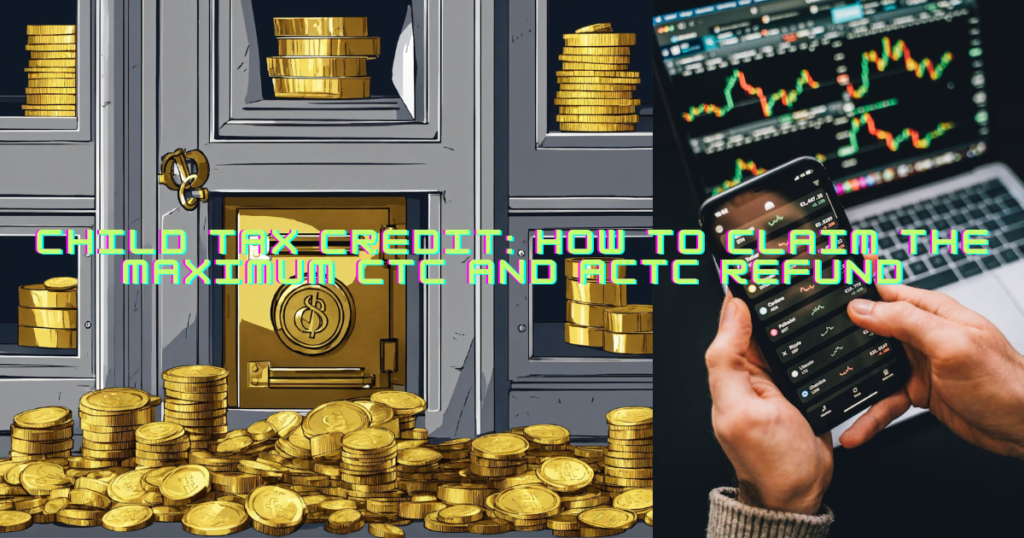The Child Tax Credit (CTC) stands as a vital support for families with qualifying children, providing a means to alleviate tax burdens. As we delve into the intricacies of the 2023 tax year, an exploration of the CTC and the Additional Child Tax Credit (ACTC) becomes paramount, especially with potential amendments looking for 2024. This comprehensive guide aims to equip you with a nuanced understanding of the CTC and ACTC refund, unraveling ten pivotal points that could significantly influence your tax refund in the upcoming season.

Child Tax Credit: How to Claim the Maximum CTC and ACTC Refund in 2024
- Who qualifies for the CTC?
- How much is the CTC worth?
- What is the ACTC?
- How do you claim the CTC and ACTC Refund?
- When will you receive your CTC and ACTC refund?
- Know What is the Tax Relief for American Families and Workers Act of 2024?
- How would the bill affect your CTC and ACTC refund?
- Who would qualify for the expanded CTC and ACTC under the bill?
- What are the benefits of the expanded CTC and ACTC under the bill?
- What are the challenges and uncertainties of the expanded CTC and ACTC under the bill?
- Conclusion: CTC and ACTC Refund
- Disclaimer
Who qualifies for the CTC?
To claim the CTC, you must have a qualifying child who has a Social Security number that is valid for employment in the U.S. Your child must also be your son, daughter, stepchild, eligible foster child, brother, sister, stepbrother, stepsister, half-brother, half-sister, or a descendant of one of these (for example, a grandchild, niece or nephew).
The child must also be below age 17 at the end of the year, provide no more than half of their own financial support during the year, live with you for a period of more than half the year, be properly claimed as your dependent on your tax return, and not file a joint return with their spouse for the tax year or can file it only to claim a refund of withheld income tax or estimated tax paid. The child must also be a U.S. citizen, U.S. national or U.S. resident alien.
How much is the CTC worth?
The CTC is worth up to $2,000 per qualifying child for the 2023 tax year. However, the credit amount may reduce if your modified adjusted gross income (MAGI) exceeds certain thresholds. The CTC begins to phase out at $400,000 for married couples filing jointly and $200,000 for all other filers. The credit is reduced by $50 for each $1,000 (or fraction thereof) by which your MAGI exceeds the threshold amount.
What is the ACTC?
The ACTC is a refundable tax credit that allows you to get a refund of the CTC amount that exceeds your tax liability. For example, if you have a tax liability of $1,000 and a CTC of $4,000 for two qualifying children, you can get a refund of $3,000 through the ACTC. However, the ACTC limited to $1,600 per child for the 2023 tax year. This means that you can only get a maximum refund of $3,200 for two qualifying children, even if your CTC is $4,000.
How do you claim the CTC and ACTC Refund?
You can claim the CTC and the ACTC by entering your children and other dependents on Form 1040, U.S. Individual Income Tax Return, and with the attachment of a completed Schedule 8812, Credits for Qualifying Children and Other Dependents. You must also provide the Social Security number of each qualifying child on your tax return. If you do not have a Social Security number for your child, you may be able to claim the Credit for Other Dependents, which is worth up to $500 per dependent who is not a qualifying child for the CTC.
When will you receive your CTC and ACTC refund?
The IRS typically issues tax refunds within 21 days of receiving your tax return, unless there are errors, incomplete information, or identity theft issues. However, due to the COVID-19 pandemic, the IRS may face some delays in processing tax returns and issuing refunds. You can check the status of your refund using the Where’s My Refund? Use tool on the IRS website or the IRS2Go mobile app. You will require your Social Security number, filing status, and right refund amount to access your refund information.

Know What is the Tax Relief for American Families and Workers Act of 2024?
The Tax Relief for American Families and Workers Act of 2024 is a nonpartisan legislation that was announced on Jan. 16, 2024, and passed by the House of Representatives on Jan. 31, 2024. The bill is heading to the Senate for further consideration. The aim of bill to temporarily modify and expand the CTC and the ACTC for the 2024 tax year, as part of the economic relief package for the COVID-19 crisis. The bill proposes to increase the CTC amount to $3,000 per child ($3,600 for children under age 6), make the credit fully refundable, and allow monthly payments of the credit to eligible families.
How would the bill affect your CTC and ACTC refund?
If the bill becomes law, you may be eligible for a larger CTC and ACTC refund for the 2024 tax year. For example, if you have two qualifying children, one under age 6 and one over age 6, you may be eligible for a CTC of $6,600 ($3,600 + $3,000) and an ACTC of $6,600, assuming your income does not exceed the phase-out thresholds. This means that you could get a refund of up to $6,600 through the ACTC, instead of the current maximum of $3,200.
The bill also proposes to allow the IRS to advance half of your CTC amount in monthly payments from July to December 2024, based on your 2023 tax return. This means that you could receive up to $275 per child per month ($300 for children under age 6) in 2024, and claim the remaining half of your CTC amount when you file your 2024 tax return.
Who would qualify for the expanded CTC and ACTC under the bill?
The bill would expand the eligibility for the CTC and the ACTC to include 17-year-old children and children with Individual Taxpayer Identification Numbers (ITINs). The bill would also raise the income thresholds for the phase-out of the credit to $150,000 for married couples filing jointly, $112,500 for heads of household, and $75,000 for all other filers. The credit would be reduced by $50 for each $1,000 (or fraction thereof) by which your MAGI exceeds the threshold amount.
What are the benefits of the expanded CTC and ACTC under the bill?
The bill would provide significant financial relief and support to millions of families with children, especially low-income and middle-income families, who have been hit hard by the COVID-19 pandemic. The bill would also help reduce child poverty and inequality, boost consumer spending and economic growth, and improve child health and education outcomes. According to the Center on Budget and Policy Priorities, the bill would lift 4.1 million children above the poverty line, cut the child poverty rate by more than 40%, and benefit 27 million children who currently receive a partial or no CTC because their families’ incomes are too low. CTC and ACTC Refund
What are the challenges and uncertainties of the expanded CTC and ACTC under the bill?
The bill faces some challenges and uncertainties before it can become law. This bill still needs to pass the Senate, where it may face opposition or amendments from some lawmakers. The bill also needs to be signed by the President, who has expressed support for the expansion of the CTC and the ACTC. The bill also poses some administrative and logistical challenges for the IRS, which would need to update its systems and procedures to implement the changes to the credit and the monthly payments.
The IRS would also need to provide clear guidance and outreach to taxpayers on how to claim the credit and the payments, and how to avoid potential errors or fraud. The bill also raises some questions and concerns about the impact of the expanded CTC and the ACTC on the federal budget, the tax system, and the social safety net.
Conclusion: CTC and ACTC Refund
As we navigate the intricacies of the CTC and ACTC, a thorough understanding of the qualifications, amounts, and potential legislative changes is essential. The upcoming amendments for the 2024 tax year present an opportunity for families to benefit further. Staying informed about the evolving landscape of tax credits and legislative developments positions you to maximize your tax refund and contribute to the economic recovery in these challenging times.
Disclaimer
This article has been created on the basis of internal data, information available publicly, and other reliable sources to be believed. The article may also include information which are the personal views/opinions of the authors. The information included in this article is for general, educational, and awareness purposes only and is not a full disclosure of every material fact.
All the information on this website i.e. World Virtual CFO – is published in good faith and for general information purposes only. World Virtual CFO does not make any warranties about the completeness, reliability, and accuracy of this information. These are my views for only information purposes. Any action you take upon the information you find on this website (World Virtual CFO), is strictly at your own risk. World Virtual CFO will not be liable for any losses and/or damages in connection with using our website. For details please refer to our disclaimer page.
Dr. Dinesh Sharma is an award-winning CFO and AI strategist with over two decades of experience in financial leadership, digital transformation, and business optimization. As the founder of multiple niche platforms—including WorldVirtualCFO.com—he empowers professionals and organizations with strategic insights, system structuring, and innovative tools for sustainable growth. His blogs and e-books blend precision with vision, making complex financial and technological concepts accessible and actionable.